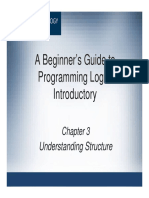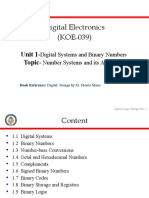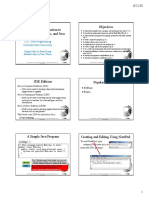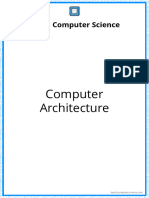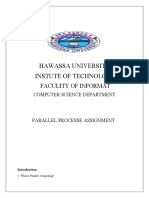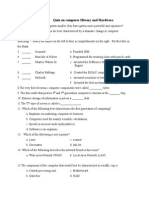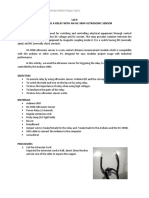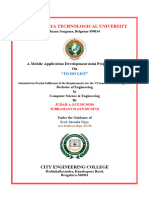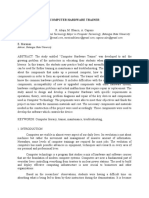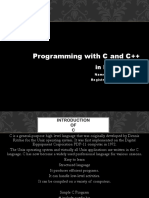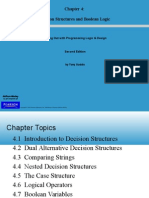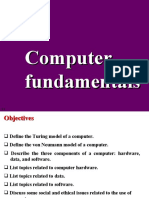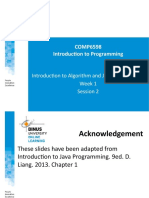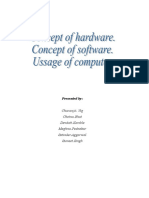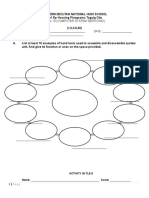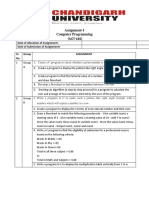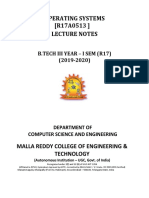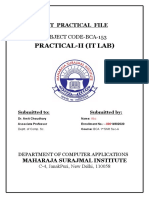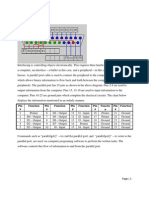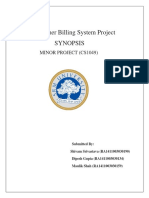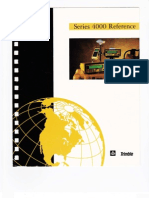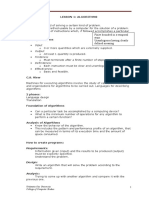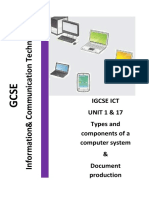FUNDAMENTALS OF
COMPUTING
Jeffin Joseph
Asst Professor
BIMS
�INTRODUCTION TO COMPUTERS
Computer-derived from a Latin word computare
which means to compute or to calculate
Definition
The computer is an electronic device which converts
raw data into valid (or) meaningful information.
�BASIC OPERATIONS OF A COMPUTER
Input : It is the process of capturing or acquiring the
raw data.
Process :It is the transformation process to convert the
input into output.
Output :It is the result, which comes from the
transformation process or it is the outcome of the
process.
Storing: It is the process of saving the data or
information or instruction , so that they can be
retained and retrieved whenever required.
Controlling: It is the process of directing the manner
and sequence in which all the operations are to be
performed.
�CHARACTERISTICS OF A COMPUTER
Speed
Speed is the most important characteristics of a
computer. Computers have more speed to perform
jobs instantaneously. It can perform in a few
seconds , the amount of work that a human being
can do in an entire year.
A powerful computer is capable of adding two
twenty digit numbers in 300 nano seconds
�CHARACTERISTICS OF A COMPUTER
Accuracy
The accuracy of the computer is consistently high.
The computers are perfect accurate and precise. It
never makes any mistake.
Automatic
The computer works automatically, once programs
are stored and data given to it. Constant
supervision is not required .Individual instructions
are transferred one after other to the control.
�CHARACTERISTICS OF A COMPUTER
Diligence
The computer can go working continuously and
does not suffer from human traits of tiredness
and lack of concentration.
If three million calculations have to be
performed ,it will perform the third millionth
instruction with exactly the same accuracy and
speed as the first instruction.
�CHARACTERISTICS OF A COMPUTER
Versatility
The computer can be put to various jobs and has
applications in various fields.
Computers have key role in fields such as space
exploration, weather forecasting,research,office
automation,teaching,railways,medicine,industry,
and banking.
�CHARACTERISTICS OF A COMPUTER
Storage
The computers processes limitless quantities of
data and information. With more and more
auxiliary storage devices, which is capable of
storing huge amount of data ,the storage capacity
of computers is unlimited.
�CLASSIFICATION OF COMPUTERS
BASED ON SIZE AND CAPACITY
Micro computer
Minicomputers
Mainframes
Super computers
�CLASSIFICATION OF COMPUTERS
BASED ON SIZE AND CAPACITY
Microcomputers
Smaller computers
CPU is usually a single integrated circuit
Minicomputer
Minicomputers are scaled up version of micro
computers with moderate speed and storage capacity
�CLASSIFICATION OF COMPUTERS
BASED ON SIZE AND CAPACITY
Mainframe
Mainframe computers are implemented using two
or more central processing units.
It is capable of supporting hundreds of users
simultaneously.
Supercomputer
A supercomputer is an extremely fast computer
that can perform hundreds of millions of
information's per second.
�CLASSIFICATION OF COMPUTERS
BASED ON UTILITY
General Purpose computers
Special purpose computers
CLASSIFICATION OF COMPUTERS
BASED ON HARDWARE DESIGN
Analog
Digital
Hybrid
�CLASSIFICATION OF COMPUTERS
BASED ON MODE OF USE
Palmtop PCS
Laptop PCs
Personal computer
Work station
Mainframe system
Clients and Servers
�BASIC COMPUTER ORGANIZATION
The architecture of the computers have not
changed but the technology used to accomplish
those operations may vary from one computer to
another.
However, the basic computer organization
remains the same for all the computer systems.
In 1950s it took a room full of vacuum tubes and
equipment to perform the tasks that are now
replaced with a single chip, not bigger than a
child's thumb nail.
�ARCHITECTURE
The basic architecture of a computer system consist
of .
The input unit
Central processing unit
Output unit
�ARCHITECTURE
�INPUT UNIT
Computers must need the data and instructions
in order to solve any problem.
Therefore, we need to put the data and
instructions into the computers .
The input unit consists of one or more input
devices.
The keyboard of the computer is one of the type
of input devices used in the computer system.
�FUNCTIONS OF INPUT UNIT
Accept data and instruction from the outside
world.
Convert it to a form that the computer can
understand.
Supply the converted data to the computer
system for further processing.
Input may be pressing a key in the keyboard or
moving of the mouse.
�CENTRAL PROCESSING UNIT
It is the heart of the computer system.ie all
operations are carried out in this unit only.
It performs all calculations
It takes all decisions
It controls all units of the computer
�CENTRAL PROCESSING UNIT
The CPU can be subdivided into the following four
sub-system.
1)Control unit
2)Arithmetic logic unit
3)Memory unit
4)Secondary Storage
�CONTROL UNIT
The control unit instruct the computer how to
carry out a program instruction.
It controls and co-ordinates the entire computer
system.
The input unit does not know when to receive
data and where to put the data in the storage
unit after receiving it.
The control unit gives the necessary instructions
to the input device
�CONTROL UNIT
The control unit instructs the input unit where to
store the data after receiving it from the user.
In the same way, it controls the flow of data and
instructions from the storage unit to ALU.
It also controls the flow of the results from ALU
to the storage unit.
The control unit also controls what should be
sent to the output unit.
�ARITHMETIC AND LOGICAL UNIT
Arithmetic logic unit performs all the arithmetic
and logical operations.Arithematic operations
like Addition,Substraction,Multiplication and
Logical operations such as comparison are
performed by ALU.
Whenever any calculation has to be done, the
control unit transfers the required data from the
storage unit to ALU.
�MEMORY UNIT
Memory is part of a computer which holds data
for processing and other information. It is called
main memory.
The information given from the input unit is
immediately stored in the main memory.
It is a Temporary Storage (volatile ) i.e. when the
power is OFF, the stored information in the main
memory is lost, to avoid this situation ,we can
store immediately in secondary memory.
�SECONDARY MEMORY
The secondary memory is used like an archive. It
may store several programs,documents,databases
etc.
The program that you want to run on the
computer is first transferred to the primary
memory before it can run.
Similarly, after running the program, if u need to
save the results ,you will transfer them to
secondary memory.
The secondary memory is slower and cheaper
than the primary memory.
It is non volatile.
�OUTPUT UNIT
Devices used to get the response or result of a
process from the computer is called output.
The output unit of a computer provides the
information and results of a computation to the
outside world.
Printer display screen are commonly used output
devices.
�COMPONENTS OF A COMPUTER
Hardware
CPU
Peripherals
Software
System
Software
Application software
�HARDWARE
CPU COMPONENTS
Motherboard
All the electronic components in a PC are
mounted on a Printed Circuit Board(PCB),called
the motherboard.
Processor
The microprocessor or the central processing
Unit is the computers most important
component.
�HARDWARE
CPU COMPONENTS
RAM chips
When a computer is switched on and is running a
program(RAM ) is used to hold the program and its
data. But when the computer is switched off, anything
in RAM is lost.
Hard disk drive
It is our computers main permanent storage units,
holding large amounts of data and storage.
�TYPES OF MEMORY AND DEVICES
Memory can be classified into
Primary or main memory
Secondary Memory
Primary memory
In all computers semi-conductors are used for
primary memory storage. It is divided into two
portions
RAM
ROM
�READ ONLY MEMORY
It is inbuilt in the computer at the time of its
production.
ROM is otherwise called firmware also.
It stores a set of instructions permanently which
instructs the computers how to work.
PROM
EPROM
�RANDOM ACCESS MEMORY
This is apart of computers local memory where
the computer stores all the data and instructions
it receives from the input and the results as it
works through the calculations.
The RAM requires very littlie time for access to
each data and is considered to be the fastest
memory.
�ROM
It is non-volatile
memory
The contents are
permanent
Cost effective
Available in high
storage capacity
Processing speed is
low
RAM
It is a volatile
memory
The contents are
temporary
Cost is very high
Available in smaller
capacity
Processing speed is
high
�SECONDARY MEMORY
Floppy disk
Magnetic tapes
Hard Disk
CD-ROM
�CACHE MEMORY
A small memory between CPU and main memory
is called cache memory.
.
CPU
CACHE
MEMORY
Primary
memory
Secondary
memory
�CACHE MEMORY
Advantages
It stores the current information
Reduces the access time
Increases the performance
Increases the speed of CPU
Fast accessing
�INPUT OUTPUT DEVICES
Keyboard
Monitors
Mouse
Scanner
Printer
Cables and connectors
�COMPUTER SOFTWARE
Introduction
The
computer is a machine and it can not think and
do its own. Since it has no intelligent quotient, it
must be instructed to carry out any task.
Hence it is required to specify the set of sequential
instructions that the computer can perform to solve
any task.
�COMPUTER SOFTWARE
Software
It is basically the set of instructions grouped
into programs that make the computer to
function in the desired way. It is a collection of
programs to perform a particular task
Program
A program is the set of instructions written in
any high level language that can be understood
by the computer
�COMPUTER SOFTWARE
Software
System
Software
Application
Software
Operating
Systems
Word
Processors
Compilers
Spreadsheets
Assemblers
Image
processors
�SYSTEM SOFTWARE & APPLICATION
SOFTWARE
System software is a collection of programs
designed to operate ,control and extend
processing capabilities of computer and which
makes the operation of a computer system more
effective and efficient.
Application software is a set of programs ,that
allows the computer to perform a specific data
processing job for the user .It helps the user to
work faster more effectively and more
productively.
�BASICS OF PROGRAMMING
LANGUAGES
Language is the communication media, the
computer languages are used to communicate
with the computers.
Computer languages are formed with the group
of instructions,offenly called programs.
�BASICS OF PROGRAMMING
LANGUAGES
Language
Machine
Assembly
High level
�MACHINE LANGUAGES
The machine language is formed with the help of
binary digits. These are so named as the machine
can directly understood the programs.
Advantages
The computer can understand the instructions
immediately
No translation needed
Disadvantages
Machine Dependent
Programming is very difficulty
�MACHINE LANGUAGE
In a machine language the procedure of adding 3
and 9 is performed as follows
Equivalent binary for 3
10 = 00112
Equivalent binary for 910 =10012
0011
1001
1100(2)
Hence answer is 1100(2) =12 10
�ASSEMBLY LEVEL LANGUAGE
This language is formed with the help of
mnemonic codes.
The programs can be written using codes instead
of 0 s and 1 s
These programs must be translated into the
machine understandable form
�ASSEMBLY LEVEL LANGUAGE
Advantages
Easy to understand
Easy to modify and isolate error
Disadvantages
Machine dependent language
Requires translator
Difficult to write
�ASSEMBLY LEVEL LANGUAGE
In assembly level language the addition of 3 and
4 is performed as follows.
Say A=3 B=4
MVI A
( move a value to accumulator)
ADD B
( add B with contents of accumulator)
STA C
(Store accumulator contents to C)
HLT
(Halt the program)
�HIGH LEVEL LANGUAGES
These languages are in the form of normal
English. So programming in these languages are
very easy, but it also requires a translator to
translate this program into machine
understandable form.
Advantages
Easy to write and understand
Easy to isolate an error
Machine independent language
Disadvantages
Needs translator
Requires high execution time
�HIGH LEVEL LANGUAGE
In high level language the addition of 3 and 9 is
performed as follows
LET A=3
LET B=9
LET C=A+B
PRINT C
END
�DIFFERENCE B/W
MACHINE,ASSEMBLY,HIGHLEVEL LANGUAGE
Feature
Machine
Assembly
High level
Form
0,s and 1,s
Mnemonic
codes
Normal English
M/c
Dependency
Independent
Dependent
Independent
Translator
Not needed
Needs
Needs
Execution Time Less
Less
High
Nature
Difficult
Difficult
Easy
Memory Space
Less
Less
More
�C LANGUAGE OVERVIEW
The
C programming language is a general-purpose,
high-level language that was originally developed by
Dennis M. Ritchie to develop the UNIX operating
system at Bell Labs.
The UNIX operating system, the C compiler, and
essentially all UNIX applications programs have
been written in C. The C has now become a widely
used professional language for various reasons.
Easy to learn
Structured language
It produces efficient programs.
It can handle low-level activities.
It can be compiled on a variety of computer platforms
�WHY C++?
C++ is a statically typed, compiled, generalpurpose, case-sensitive, free-form programming
language that supports procedural, objectoriented, and generic programming
It is the object oriented implementation of C
C++ was developed by Bjarne Stroustrup starting
in 1979 at Bell Labs in Murray Hill, New Jersey,
as an enhancement to the C language and
originally named C with Classes but later it was
renamed C++ in 1983.
�ADVANTAGES OF JAVA
Platform
independent: Unlike many other programming
languages including C and C++, when Java is compiled, it
is not compiled into platform specific machine, rather into
platform independent byte code.
This byte code is distributed over the web and interpreted
by virtual Machine (JVM) on whichever platform it is
being run.
Simple: Java is designed to be easy to learn. If you
understand the basic concept of OOP,Java would be easy
to master.
Secure: With Java's secure feature, it enables to develop
virus-free, tamper-free systems. Authentication techniques
are based on public-key encryption.
�WHAT IS AN IDE ?
Visual Studio.NET and Net Beans
�SCRIPTING LANGUAGES
Ahigh-level
programming languagethat
isinterpretedby another program atruntime rather
thancompiled by the computer's processor as other
programming languages (such asCandC++) are.
Scripting languages, which can be embedded
withinHTML, commonly are used to add
functionality to a Web page, such as different menu
styles or graphic displays or to
servedynamicadvertisements.
These types of languages are client-side scripting
languages, affecting the data that the end user sees
in abrowserwindow.
Javascript,ASP.NET,PHP
�LANGUAGE TRANSLATORS
Compiler: It is a program which is used to
convert the high level language programs into
machine language.
Assembler: It is a program which is used to
convert the assembly level language programs
into machine language
Interpreter: It is a program, it takes one
statement of a high level language program,
translates it into machine language instruction
and so on.
�COMPARISON BETWEEN COMPILER
AND INTERPRETER
Compiler
Interpreter
A compiler is used to compile an
An Interpreter is used to
entire program and an
executable program is generated
through the object program.
translate each line of the
program code immediately as it
is entered.
The executable program is
The executable program is
stored in a disk for future use or
to run it in another computer.
generated in RAM and the
interpreter is required for each
run
The compiled programs run
The interpreted programs run
faster.
slower
Most of the languages use
A very few languages use
compiler.
interpreters



